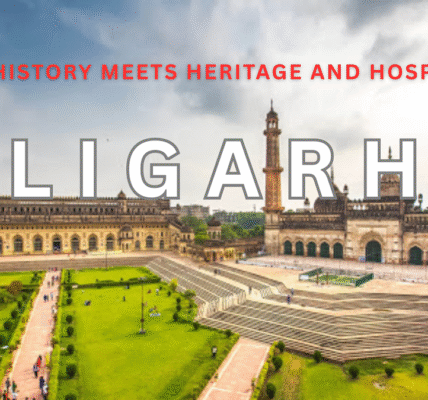The rich tapestry of Lucknow’s history includes revolutionary uprisings, regal dynasties, and cultural splendor. Lucknow, also known as the “City of Nawabs,” has been associated for centuries with deep-rooted tradition, breathtaking elegance, and a harmonious society.
From its legendary beginnings in Lucknow’s prehistoric past to the regal grandeur that characterized the Nawabi dynasty and the pivotal years of British history, each period has influenced the city’s distinct character.
We are going to explore the history of the city of Lucknow, look into the history of the nawab, investigate the historical context of Lucknow, and use the Lucknow history of culture to comprehend the cultural core of the city. What is what is known of the city of Lucknow, then? Let’s travel forward in time and find out.
Ancient Heritage of Lucknow: Legendary Origins and Initial Settlements
Lucknow’s ancient city history dates back to the legendary period of the Ramayana. According to mythological tale, Lakshmana, who was Lord Rama’s younger brother, founded a settlement named Lakshmanpur city along the branches of the Gomti Creek River. As time passed, this legendary settlement developed and became known as Lucknow.
Although these preliminary mentions are mainly rooted in mythology, archaeological findings point to the existence of pre-historic civilizations in the Awadh Valley region. The essence of Lucknow’s historical background is constituted by this continuity alongside history.
Lucknow’s ancient history is connected to the wider historical past of northern India, shaped by kingdoms such as the Mauryas, the, Guptas, and furthermore, the Delhi Sultandom.
In and around the city, remnants of temples, small forts, and trade routes from prehistoric periods have been discovered, providing insights into the early development of what would become a culturally rich metropolitan area.
Historical Development of Lucknow City: A Dynastic Evolution
The administrative center of Uttar Pradesh, Lucknow, is characterized by a rich and the complex history influenced by numerous royal periods. Its ancestors go back to antiquity, accompanied by the belief that it was established by Lakshman, Lord Rama’s brother, and accompanied by preliminary indications in legends from the Rama story period.
Lucknow came under the control of the Delhi’s Sultanate in the 11th century, but it rose to true prominentness in the 18th century subsequent to the rule of the Nawabs of Awadh. Nawab Saadat Khan was appointed as Awadh’s first Nawab by Mughal Emperor Abdulaziz Shah in 1722.Durant the Nawab era, particularly under Asaf-ud-Daula’s rule, the city thrived as a hub for art, music, poetry, and Persian civilisation. This era saw the construction of grand architectural wonders such as Bara Imambara Monument and Rumi Darwaza, which became symbols of Lucknow’s refinement and grace
In the 19th decade, the British East India Company took over control of Awadh city, formally annexation it in 1856. This situation ignited extensive tumult, conducting to the First War of Independence in 1857. The Residency was the site of intense fighting, as Lucknow served as a key hub of opposition. After the rebellion, the British enhanced their control and reconfigured the city using colonial structures and organization’s.
Despite under colonial domination, Lucknow persisted as a center of cultural unity, where Hindu and Muslim traditions merged without difficulty. Following India’s independence in 1947, it turned into a modern city while maintaining its historical magnetism.
In the present, Lucknow embodies a dynamic fusion of its regal history and modern development, showcasing its evolution throughout various dynasties and periods. The architecture, language, cuisine, and rituals of the city continue to reflect its historical legacy.
Nawabi Era in Lucknow: The Highpoint of Elegance
Lucknow’s Nawabi era is arguably the most famous emblematic and controversial time period in the city’s heritage. Tales of generousness, refinements, and the grand approval of creative fields and literary works fill the history of the Lucknow the Nawabs.
This period, often referred to as the golden age, turned Lucknow into a shining example of sophistication, visual art, and Indo-Islamic heritage.
This particular period saw the rise of Nawab Asaf-ud-Daula, one of its most renowned leadership. He moved the administrative center from Faizabad city to Lucknow city and sparked the construction of astonishing conceptual works such as the Bara Imambara and the Rumi Palace. These silhouettes continue to serve as brilliant representations of the city’s abundant building-making heritage.
During the Nawab Shahi period in Lucknow, traditional dance forms such as Kathak flourished, the Urdu language evolved, and unique culinary traditions blossomed. During this time, the Ganga-Jamuni Tehzeeb—a ethnographic ethos founded on Hindu-Muslim harmony—came to symbolize the traditionnel history of Lucknow.
Another remarkable aspect of the past of the Lucknow nawabs is the patronage of poets, musical figures, and craftworkers by the monarchial court. Nawabs similar as Wajid Ali Shah were talented artists in their own right who fostered creativity, resulting in a cultural explosion that will shape the city’s identity.
Lucknow Architectural History: An Interweaving of Visual Arts, Music, and Tehzeeb

The cultural history of Lucknow is one of the richest in India, largely due to the patronage provided by during the Nawabi era. From advanced courtly behaviors to exquisite food and stylish clothing, Lucknow’s culture developed into a polished and all-embracing lifestyle.
The town surmounted as a center for Urdu literature, with poetry writers such as Mir Taqi Mir Taqi, Mirza Dabeer, and Mir Anis rising to prominence. The custom of poetry meetings (poetic gatherings) and qawwalis (Sufi devotional music) thrived. Traditional instruments and gymnastic were also fostered, especially via the Kathakali performing style, which occurred to embody elegance and composure.
Throughout this period, chikankari—a complex type of hand embroidery that began in Lucknow—also gained fame. It remains an essential element of Lucknow’s ethnographic civilization and is renowned worldwide for its creative abilities.
Following this particular time, cuisine traditions like galouti kebabs, sheermal, biryani, and nihari recipes came into existence, transforming integral to the city’s distinctiveness. The contributions from this period render the Nawabi era of Lucknow as a cultural renaissance as well as a political achievement.
Lucknow British History: Colonial Influence and the Rebellion of 1857
The mid-19th century marked the beginning of a new era in Lucknow’s history with the advent of Britisher authority. The history of the Britian in Lucknow Province started with the growing British involvement in Awadh’s internal government affairs. The British annexed Awadh in 1856, removing Nawab Wajid Ali Shah from power through the controversy-based Constitution of Lapse.
This resulted in extensive turmoil, ultimately resulting in the 1857 Revolt, a significant occurrence within the Lucknow British history. The city emerged as a key hub of opposition to British colonial rule. While in this revolt, the Rebellion of the Residency occurred—a significant event in British and Indian heritage that is well-documented.
For a numbering of months, Indian insurgents encircled British troops at the Lucknow Residency. The British managed to suppress the revolt in the end, but the siege came to symbolize Indian bravery and resistance. Individuals such as Begum Hazrat Mahal took on legendary roles, earning her reverence in Lucknow’s historical context.
Post-revolt, Lucknow came under unqualified British administration. Part of the Lucknow’s British history is the city’s evolution into an administrative and educational center, with pre-colonial structures such as La Martiniere College and the British Residency serving as tangible reminders of that time.
Historical Roots of Lucknow: A Melting Pot of Heritage
Lucknow’s historical background combines mythological origins, royal splendor, colonial combats, and ethnographic brilliance. Every period, from Lucknow’s ancient history to its British colonial era, has played a part in molding the city’s complex identity.
Lucknow city is distinguished by its history, having been a place where great leaders and revolutions emerged, as well as a nurturing ground for historical advancement. The historical narrative of This historical city reflects resilience, adaptability, and ongoing evolution. Lucknow has consistently represented coexistence and elegance, depending on whether through the Nawabi fervor for poetry or the colonial ambition for modernization.
The advancement of the city embodies the central inquiry: What historical narrative exists Lucknow city have? The solution is found in this unified blending of eras, values, and narratives that persist today.
How has Lucknow City developed over time? A Comprehensive
Perspective What is the historical background of Lucknow city? This narrative cannot be simplified. This tale starts with age-old myths, blooms in the magnificence of the Nawabs’, and confronts the brutal truths of colonial domination.
This particular narrative encompasses more than just dates and occurrences; it concerns ways of life, customs, beliefs, and languages. From the mystical origins of Lucknow’s ancient history to the poetic brilliance of the Nawabi era and the resistance found in Lucknow’s British tradition, each phase contributes a chapter to the city’s legacy.
One can genuinely comprehend the history of Lucknow city by strolling through its ancient markets, admiring its historical structures, enjoying its food, and being part of its celebrations. These experiences serve as living proof of Lucknow’s historical background, preserved by generations who continue to value and honor their origins.
Legacy of the Nawabs architecture in Contemporary Lucknow
The historical influence of the Lucknow nawabs remains evident in the city’s architecture, arts, and social structure. The Nawabi era of Lucknow continues to influence modern life, from the grand gateways and imambaras to the language and manners of its inhabitants.
Entities such as the Lucknow Mahotsav (cultural fair), Urdu academies, and music gharanas preserve the essence of Nawabi culture. Constant life in City of Lucknow embodies its cultural history, from the ways people greet one another to their cooking and dressing practices—far far from the confines of museums.
This existential legacy addresses the age-old question: What is the history of the city of Lucknow? It is a history that continues to be lived, not merely recalled.
Conclude: A City Established in History, Advancement into the Future
Lucknow’s historical past encompasses more than just stories of rulers and revolutions; it embodies the spirit of a city that has endured through the ages. the city of Lucknow, with its profound architectural legacy, vibrant heritage, and unbroken populace, continues to serve as a symbol of enricher national pride.
Emerge from the tales of its ancient history to the magnificence of the Nawabi era and the challenges faced during Lucknow’s British history, each layer of the past continues to influence its identity. No matter if you’re a traveler, historian, or culture lover, the history of Lucknow city provides an enriching exploration of North India’s essence.
The upcoming time someone inquires, “What is the history of Lucknow city?”, respond that it’s more than just a history—it embodies a living legacy filled with beauty, struggle, and grace.





